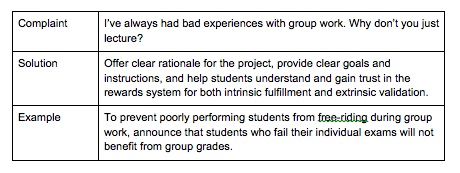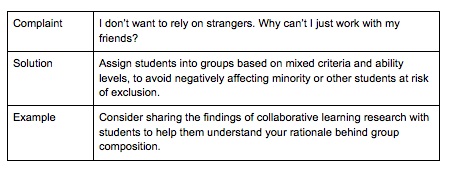'Group Work' Has Lasting Benefits Beyond K-12

Group work has been implemented successfully for years at the K-12 level, but has been slow to catch on within higher education. Group work, or cooperative learning, offers a host of benefits to both students and educators when successfully implemented. Here are some of the top reasons you might want to consider integrating group work into your next course:
Benefits to Students
- Promotes deep learning of course materials through peer interaction
- Helps students achieve better grades than competitive or individual learning
- Teaches social skills and civic values
- Helps students to develop and hone critical thinking skills
- Enables students to achieve personal growth
- Develops positive attitudes toward autonomous learning
Benefits to Instructors
- Provides time to reflect on what is happening in the classroom, rather than being on stage
- Decreases grading load by reducing the assignments to be graded
The Group Life Cycle
In order to achieve these successful cooperative learning outcomes, I recommend taking a systematic approach that relies on fundamental principles from social psychology and small group literature. The life cycle of groups offers a helpful framework for organizing group work and anticipating problems before they take hold.
The life cycle comprises three stages: a design and development stage, an operations stage, and an output and disbanding stage (Oakley, Felder, Brent, & Elhajj, 2004; Rousseau, Aube, & Savoie, 2006). Each stage generates different types of problems and requires different types of guidance and intervention. I’ll take a closer look at each stage and how you can best navigate around potential issues for the most productive cooperative projects.
Stage 1: Design and Development
The design and development stage begins when a group forms and starts developing the necessary competency to work together. It is here that rules, policies, and strategies for working together must be established (Hare & O'Neill, 2000).
Establish group goals and rewards

At the outset of a new group work assignment, it is common for students to think back upon the prior negative experiences they have had with such projects in the past. In order to avoid an unenthusiastic reception, you must provide clear goals, instructions, and importantly - rationale for why you are assigning the project in the first place.
In addition to establishing goals and process, a key component to ensuring a positive student reception of the project is ensuring that students know, understand, and trust the rewards system in place. A reward system needs to incorporate both social interdependence and individual responsibility, and must justify the effort students are putting forth, lest your students lose faith in the system.
Control group composition

Because self-selection can negatively affect students at risk of exclusion, consider taking control of selection and mixing your class into small groups based on a variety of criteria. Such criteria can be collected on the first day of class, using a standard format (Oakley et al., 2004). Creating groups based on mixed ability levels may better promote the achievement of all students while also allowing high-performing students to take a leadership role, leading to deeper learning. To discourage social loafing and limit the number of relationships managed in each group, I recommend capping teams at four members.
While some scholars have argued stable groups may lead to better outcomes (Delucchi, 2006), creating practice groups at the start of the semester can help avoid confusion if students add or drop the class (Felder & Brent, 2001). It may also serve to reduce student anxiety about working apart from their friends.
Develop students’ social skills

Effective groups are not created simply from a selection process. In many cases, students may lack the social skills necessary to actually accomplish their group objectives. You should anticipate this and act accordingly.
You can help form effective collaborations by teaching social skills directly (O'Donnell & O'Kelly, 1994). This might take the form of written instructions for working together, or lectures that describe effective group processes and warn against common pitfalls. Discussing “tips from survivors” (Caulfield & Persell, 2006) can also help mitigate students’ anxiety about working within a new social group.
Social skills can also be indirectly taught by structuring students’ interactions with peers. This skill development might take place through team-building exercises (McKinney, McKinney, Franiuk, & Schweitzer, 2006). Skills can also be fostered through templates that track group progress, or through role-assignments that create divisions of labor and discourage free-riding (Cohn, 1999).
Stage 2: Operation
In the second stage of the group life cycle, group members start to invest more time and effort in working toward shared goals. However, this stage can also be characterized by problems such as free-riders and domineering members. To successfully make their way through these challenges, members need feedback and assurance from their instructors, and time to reflect on and evaluate their performance.
Design transparent task and reward systems

Groups cannot work together successfully without a clear map of where they are going. In fact, the quality of outcomes from group meetings is determined before the group meets, and depends on how well group members are prepared. This is where your investment of time in the design and development stage will lead to better outcomes for the group.
To avoid student confusion, you should clearly define what the expected output for each task is, and instruct students on how to report the output. I recommend putting all instructions in writing for students to refer back to, either in handouts or on a course web page. Start groups out with easier tasks and simpler assignments (O'Donnell & O'Kelly, 1994), and limit the size of the task to the duration and frequency of group activities.
Monitoring and intervention

Group work isn’t an opportunity for instructors to sit on the sidelines, and in fact requires active monitoring throughout the process to ensure the best outcomes. The best thing you can do as groups work together is be available, which will help students achieve a sense of security.
As students continue their work together, give them opportunity to provide negative feedback about other members’ citizenship. Query your groups anonymously and regularly, and intervene quickly when problems arise. You may need to call out missing group members, be available outside of class to resolve group issues, or set aside class time for groups to work together. In rare cases, you may need to be prepared to “fire” students who cause problems for their groups, or dissolve entire groups.
Stage 3: Output and Disbanding
This stage occurs when groups wrap up their work at the end of a unit or course. Here, it is important for students to feel a sense of achievement both as a member of the group and as an individual. A successful group deliverable is one thing, but personal growth is another. Unless group members feel they have a chance to gain new knowledge or perspectives, or refine old ones, working in a group will be less attractive to them than working independently.
Provide prompt feedback

Throughout the group work process, you will want to maintain a consistent and transparent reward system. In such a system, preserving consistency might require you to grade social or cognitive loafers separately (Felder & Brent, 2001).
At grading time, it is essential to treat groups’ output seriously. If something is wrong with the output, it is possible that the group has not functioned effectively. If you have held off intervening until now, you will now need to consider how to compensate for your inaction.
Maintain consistency with your reward system

To maintain group learning as a positive experience, not only collective but also individual needs must be satisfied. Your rewards system needs to be responsive to both the extrinsic and intrinsic demands of students.
Remember that students want to be evaluated positively for their own growth, and not only for their group products. A sense of being evaluated and rewarded impartially and justifiably is necessary for the closure of successful group operation and process.
As an instructor, you play a critical role in guiding, monitoring and framing your students’ group activities. It is your duty to motivate students to participate in group work, but also to ensure that the groups are working toward successful outcomes.
In my experience, students are aware when instructors are using group work to simply to fill up class time, and they respond in kind with lackluster cooperation and even shirking. That is why I urge instructors to explain the rationale for group projects and provide guideposts throughout the way. Students must be free to express their opinions about their projects, and you can promote that by creating and maintaining a positive sense of community in your classroom.
By maintaining a helpful, encouraging attitude, you can communicate the contributions group work makes to your students’ learning and guide them toward experiencing its successful outcomes.
References
Caulfield, S. L., & Persell, C. H. 2006. Teaching Social Science Reasoning and Quantitative Literacy: The Role of Collaborative Groups. Teaching Sociology, 34(1): 39-53.
Cohn, C. L. 1999. Cooperative Learning in a Macroeconomics Course. College Teaching, 47(2): 51-55.
Delucchi, M. 2006. The Efficacy of Collaborative Learning Groups in an Undergraduate Statistics Course. College Teaching, 54(2): 244-248.
Felder, R. M., & Brent, R. 2001. Effective Strategies for Cooperative Learning. Journal of Cooperation and Collaboration in College Teaching, 10: 69-75.
Francis, D. 1992. Improving work groups : a practical manual for team building. Amsterdam ; San Diego: Pfeiffer & Co.
Hare, L. R., & O'Neill, K. 2000. Effectiveness and Efficiency in Small Academic Peer Groups: A Case Study. Small Group Research, 31(1): 24-53.
McKinney, J. P., McKinney, K. G., Franiuk, R., & Schweitzer, J. 2006. The College Classroom as a Community. College Teaching, 54(3): 281-294.
O'Donnell, A. M., & O'Kelly, J. 1994. Learning from Peers: Beyond the Rhetoric of Positive Results. Educational Psychology Review, 6(4): 321-349.
Oakley, B., Felder, R. M., Brent, R., & Elhajj, I. 2004. Turning Student Groups into Effective Teams. Journal of Student Centered Learning, 2(1): 9-34.
Rousseau, V., Aube, C., & Savoie, A. 2006. Teamwork Behaviors: A Review and an Integration of Frameworks. Small Group Research, 37(5): 540-570.
More ideas
College business professors looking for more ideas to enrich the classroom experience can find them here.
Additional Search Terms: entrepreneurship courses, teaching ideas, teaching resources, classroom ideas, entrepreneurship classes, business schools, business school classes, entrepreneurship students, professors

Kenan Professor of Sociology / Sociology / University of North Carolina at Chapel Hill
View Profile




